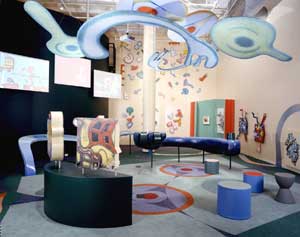| Getting
Inside the Exhibit:
‘Art
Inside Out’ at Children’s Museum
By
Marie Holmes
 It’s
hardly the first interactive art exhibition in New York City.
But for the young target audience of “Art Inside Out,” the Children’s
Museum of Manhattan’s (CMOM) current exhibition, it’s likely the
first time that they’ve been invited to touch art in a museum
setting. It’s
hardly the first interactive art exhibition in New York City.
But for the young target audience of “Art Inside Out,” the Children’s
Museum of Manhattan’s (CMOM) current exhibition, it’s likely the
first time that they’ve been invited to touch art in a museum
setting.
“The
idea is to introduce children and their families to three incredible
contemporary artists,” said the exhibit’s curator, Deborah Schwartz.
Divided into three sections devoted to the works of Elizabeth
Murray, Fred Wilson and William Wegman, the exhibit invites children
to climb “inside” the paintings, installations and photographs
on display through a number of interactive activities.
 One
section was designed around one of Murray’s paintings, “Plan 9”
(2001), which children had expressed an interest in during preliminary
visits to Murray’s studio. The work itself, protected by plexiglass,
is mounted on one wall, next to a photograph of the painting’s
wooden backside and several of Murray’s preliminary sketches.
Activities include touch screen computer programs that allow visitors
to arrange Murray’s shapes themselves, projecting their “work”
onto larger screens hung from the ceiling, giant magnets, pencil
rubbings and a “sound painting,” for which visitors don a pair
of headphones and then “play” a painting by tapping it with a
large paintbrush, with different portions of the work emitting
a variety of sounds. One
section was designed around one of Murray’s paintings, “Plan 9”
(2001), which children had expressed an interest in during preliminary
visits to Murray’s studio. The work itself, protected by plexiglass,
is mounted on one wall, next to a photograph of the painting’s
wooden backside and several of Murray’s preliminary sketches.
Activities include touch screen computer programs that allow visitors
to arrange Murray’s shapes themselves, projecting their “work”
onto larger screens hung from the ceiling, giant magnets, pencil
rubbings and a “sound painting,” for which visitors don a pair
of headphones and then “play” a painting by tapping it with a
large paintbrush, with different portions of the work emitting
a variety of sounds.
The aim, according to Schwartz, is not only to introduce children
to the diversity of mediums that artists use but also to the thought
processes that accompany technical procedures. “We want them to
really understand the excitement of making art, of looking at
art.”
In the portion of the exhibition devoted to installation artist
Fred Wilson, children are invited to arrange wooden eggs on a
countertop, magnetic people within framed images of the classroom,
cafeteria and playground as well as the type of vintage figurines
Wilson has used in some of his pieces. A computer program and
digital camera in one corner allow visitors to photograph their
arranged objects, title the piece and record an artist’s statement.
Carefully designed fragments of another set of figurines allow
visitors to rearrange the heads, bodies and bases, emulating Wilson’s
own playful process.
Wilson says that the children that he had spoken with had no difficulties
appreciating a found object piece, once they had grasped the basic
concept.
“One
of the kids said, ‘So you take other people’s artwork and you
move it around and make it your own–okay,’” recalled Wilson. “Once
they realized that they could think whatever they wanted to think
they just had fun with it.”
Designed to look like a house, the portion of the exhibit devoted
to the work of William Wegman is filled with dozens of household
items–telephone, book, brush–as well as a rack of colorful clothing.
Visitors can dress themselves up and use the props to compose
photographs against a variety of curtains, as Wegman has done
in the famous portraits of his Weimaraners.
The opportunity to interact with the art, Wegman believes, can
make subsequent museum visits less alienating. As for a young
child’s ability to comprehend the myriad concepts at play in contemporary
art, “I think that misunderstanding is as good as understanding
at that age,” said Wegman, noting that he had already seen children
visiting the exhibit using display elements in ways neither intended
nor imagined by the curators.
“I
think there are layers of my work that wouldn’t occur to adults,”
he added.#

Education
Update, Inc., P.O. Box 20005, New York, NY 10001.
Tel: (212) 481-5519. Fax: (212) 481-3919.Email: ednews1@aol.com.
All material is copyrighted and may not be printed without express
consent of the publisher. © 2002.
|
